Fabrizio Pregadio's Blog, page 3
October 9, 2012
Taoist Alchemy: A Historical Overview (Free PDF)
Golden Elixir Press is pleased to announce the publication of
The Way of the Golden Elixir: A Historical Overview of Taoist Alchemy
by Fabrizio Pregadio (PDF, 60 pp., free download).
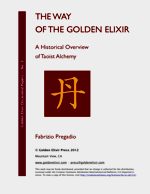
Chinese alchemy has a history of more than two thousand years, recorded from the 2nd century BCE to the present day. Its two main branches, known as Waidan (External Alchemy) and Neidan (Internal Alchemy), share in part their doctrinal foundations but differ from one another in the respective practices.
This essay outlines the main stages of development of the Chinese alchemical tradition, and the continuities and analogies that occur among the doctrines and practices of its main branches and lineages.
Download page (free download)
Contents
Introduction
1. Origins of Waidan
2. The Taiqing (Great Clarity) Tradition
3. Taoist Meditation and the Origins of Neidan
4. The Cantong qi (Seal of the Unity of the Three)
5. Waidan After the Cantong qi
6. Main Neidan Lineages and Masters
7. Neidan: General Perspectives
8. The Internal Elixir and the View of the Human Being
9. The Practice of the Internal Elixir



Chinese alchemy has a history of more than two thousand years, recorded from the 2nd century BCE to the present day. Its two main branches, known as Waidan (External Alchemy) and Neidan (Internal Alchemy), share in part their doctrinal foundations but differ from one another in the respective practices.
This essay outlines the main stages of development of the Chinese alchemical tradition, and the continuities and analogies that occur among the doctrines and practices of its main branches and lineages.
Download page (free download)
Contents
Introduction
1. Origins of Waidan
2. The Taiqing (Great Clarity) Tradition
3. Taoist Meditation and the Origins of Neidan
4. The Cantong qi (Seal of the Unity of the Three)
5. Waidan After the Cantong qi
6. Main Neidan Lineages and Masters
7. Neidan: General Perspectives
8. The Internal Elixir and the View of the Human Being
9. The Practice of the Internal Elixir

Published on October 09, 2012 05:10
September 30, 2012
"Being by Oneself": A Visit to the Residence of Neidan Master Liu Yiming (1734-1821)
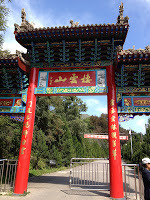
Fig. 1. Entrance
to Mount Qiyun
Liu Yiming 劉一明 (1734-1821) was one of the greatest masters of Neidan (Internal Alchemy). Born in Quwo (present-day Shanxi province), he spent the first half of his life traveling extensively to various towns and mountains in northwestern China and to Beijing, in order to search for teachings. His main teachers were a master whom he calls Kangu laoren (Old Man of the Kan Valley, first met around 1755), who gave him teachings on the Book of Changes, cosmology, and Neidan; and another master whom he calls Xianliu zhangren (Great Man Resting in Immortality, first met in 1768), who gave him further teachings on Neidan.
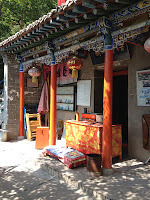
Fig. 2. First level
of the Zizai wo
In 1779, Liu Yiming visited Qiyun shan (Mount Resting on the Clouds). He decided to settle there and built his residence, called Zizai wo (meaning Nest of Being by Oneself, but also Nest of Freedom, as well as Comfortable Nest...). Since then, his main activities were teaching, writing, and building or restoring a large number of temples and shrines on the mountain. Liu Yiming's best-known works consist of commentaries on major Neidan texts, such as the Cantong qi (The Seal of the Unity of the Three) and the Wuzhen pian (Awakening to Reality); independent works on Neidan, both in prose and poetry; and commentaries on the Book of Changes. In addition, he wrote works still virtually unknown to Western readers, including a commentary to the Daode jing (Book of the Way and Its Virtue) and one to the Buddhist Heart Sutra.
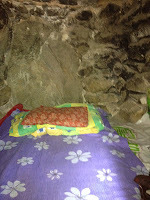
Fig. 3. Liu Yiming's
own room
Mount Qiyun is located near Yuzhong (present-day Gansu province). After one crosses the gate that formally marks the entrance to the mountain (fig. 1), it takes almost one hour to climb the steps that lead to Liu Yiming's residence. A recently-built shrine devoted to Liu Yiming is found near the foot of the mountain. Continuing the climb, one at last reaches the Zizai wo. Arranged into three levels, the residence is built around a natural cave and for this reason it is still remarkably well preserved. Most other temples and shrines on the mountain, instead, have been destroyed during the past century due to political turmoils, although a few new sites have been built in the meantime.
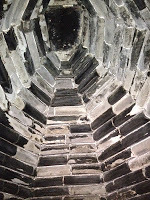
Fig. 4. The ceiling
The lower and main level of the Zizai wo is a shrine (fig. 2). The front wall is now covered by several wallboards containing Liu Yiming's life chronology, photographs of earlier Taoist masters, and other materials. On the left side is found Liu Yiming's own room, which is built directly inside the cave (fig. 3). The ceiling of the room, instead, is covered by tiles that form a octagonal shape, to represent the eight trigrams of the Book of Changes and their center (fig. 4). The terrace facing the shrine offers a spectacular view of the mountain.
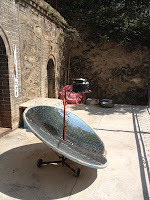
Fig. 5. Second level
of the Zizai wo
The second, intermediate level of the Zizai wo is where Liu Yiming wrote his books and prepared medicines. Although he was a Neidan master, he was often visited by people who knew him for his medical skills. In the first part of his life, his peregrinations led him to study medicine in Henan from around 1762 to 1765, and later he wrote four little-known works on ophthalmology. Healing was only one of Liu Yiming's charitable activities. His biographies mention that he bought farming land on the mountain, which he then leased in order to fund restoration or construction of temples and shrines. He also bought land to be used as burial ground by those who could not afford buying a tomb. Part of the terrace at the second level of the Zizai wo is now occupied by a simple but effective solar-energy device used for boiling water (fig. 5).
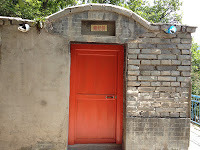
Fig. 6. Third level
of the Zizai wo
The upper level of Liu Yiming's residence is the Cangjing dong (Cave for Storing the Scriptures, fig. 6); here Liu Yiming kept his books. None of them is found in this room: the former "library" now contains an altar devoted to Liu Yiming. Considering the breadth of subjects covered in his works, nevertheless, it is easy to imagine that the Cangjing dong hosted texts on Taoism, Neidan, Confucianism, Buddhism, as well as medical books.
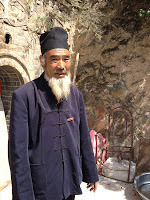
Fig. 7. Master Zhang Xincheng
Master Zhang Xincheng 張信誠 (fig. 7) takes care of Liu Yiming's residence. He is a 25th-generation master of Longmen (Dragon's Gate), the lineage to which Liu Yiming also belonged. This lineage claims direct descent from Qiu Chuji (1148-1227), one of the disciples of Wang Chongyang, the founder of Quanzhen Taoism. Longmen became formally acknowledged in the 17th century, and since then has been the main Taoist lineage in northern China.
We are grateful to Master Zhang for allowing us to visit the Zizai wo, for answering our questions on Liu Yiming and Neidan, and for offering us a delicious tea.
Text and pictures by Fabrizio Pregadio and Song Xiaokun 宋晓堃. — See also a Facebook album on the Zizai wo.

Published on September 30, 2012 04:27
July 15, 2012
Summer 2012 Catalogue
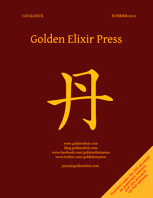
The Summer 2012 catalogue (PDF) is available. Click the picture or the link below to visit the download page:
• Summer 2012 catalogue
The catalogue includes codes for a 20% discount on paperback editions and a 10% discount on PDF editions. This offer is valid until the end of summer (September 21, 2012).

Published on July 15, 2012 07:21
June 21, 2012
"The Essential Cantong qi" (PDF)
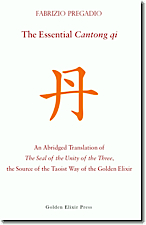
An abridged translation of the Cantong qi (The Seal of the Unity of the Three), the main text of Taoist Internal Alchemy, is now available in PDF format.
This version is based on the complete translation published in The Seal of the Unity of the Three: A Study and Translation of the Cantong qi, the Source of the Taoist Way of the Golden Elixir (Golden Elixir Press, 2011), available in both a paperback and a hardcover edition.
The PDF contains 32 of the 88 poems of the original text. Each poem is translated in full, and the explications and line notes are the same as those found in the complete version. The Introduction, the tables, the glossary of Chinese characters, and the list of works quoted are reproduced entirely. The textual notes, the appendixes, and the final index of subjects are omitted.
▶ See the web page on this PDF
▶ Download a sample (PDF, based on the unabridged version)
▶ Other materials on the Cantong qi in the Golden Elixir website

Published on June 21, 2012 15:41
June 12, 2012
"Who Wrote the Cantong qi?" (Slideshow Presentation)
The Golden Elixir website now contains an online slideshow presentation entitled "Who Wrote the Cantong qi?", on the author(s) of The Seal of the Unity of the Three.
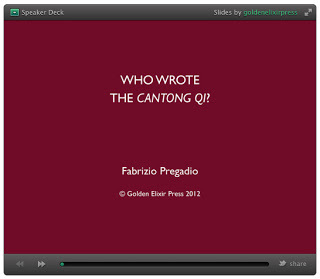
Click the picture above to visit the Golden Elixir web page where you can watch the presentation.


Click the picture above to visit the Golden Elixir web page where you can watch the presentation.

Published on June 12, 2012 08:01
May 22, 2012
A Japanese Alchemical Chart of the Body
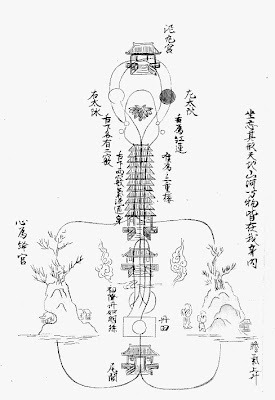
The Japanese alchemical chart of the body reproduced above is entitled Shūshin kyūten tandō zu 修真九轉丹道圖, or Chart of the Way of the Elixir in Nine Cycles for the Cultivation of Reality (the Chinese reading of the title is Xiuzhen jiuzhuan dandao tu). Although no precisely corresponding picture seems to be found in Chinese texts, it is likely that this chart is either copied from, or based on, an earlier Chinese exemplar that may now be lost.
The Chart, which is undated, is now kept in the library of Tenri University in Japan. It is reproduced here from the book by Katō Chie 加藤千恵, Furō fushi no shintai: Dōkyō to “tai” no shisō 不老不死の身体 — 道教と「胎」の思想 (The Ageless and Deathless Body: Taoism and the Idea of the “Embryo”; Tokyo: Taishūkan shoten, 2002), p. 121. Dr. Katō is one the main Japanese scholars of Taoist Internal Alchemy. She has published extensively in particular on the Wuzhen pian (Awakening to Reality) and on the Taoist views of the “embryo.”
From top to bottom along the vertical axis, the Chart shows: the upper Cinnabar Field; the eyes; the tongue; the trachea; the middle Cinnabar Field; the lower Cinnabar Field; and the Caudal Funnel.
Like most similar Chinese pictures, the Chart contains short captions. Below are translations of the captions, with short notes:
1. “Palace of the Muddy Pellet” (niwan gong). The upper Cinnabar Field, commonly called Muddy Pellet.
2. “On the left the Great Yang”. This and the next captions refer to the eyes. The left eye represents Great Yang.
3. “On the right the Great Yin”. The right eye represents Great Yin.
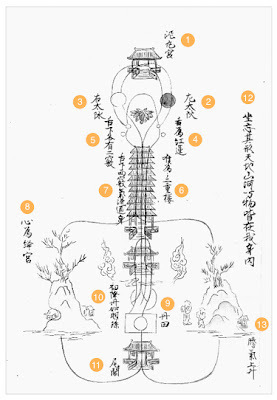
4. “The tongue is the Red Lotus” (honglian).
5. “Under the tongue, on each [side], there are two openings”. These openings are the Cinnabar Cavities (danxue), which should be kept closed by the tongue so that the True Breath (zhenqi) does not escape.
6. “The throat is the Twelve-Storied Pavilion” (shi'er lou). This is a common name of the trachea in Neidan and meditation texts.
7. “Through two [of the four] openings, Breath (qi) flows and pervades the body”.
8. “The heart is the Crimson Palace” (jianggong). The middle Cinnabar Field, commonly called Crimson Palace, is shown at the center of the picture.
9. “Cinnabar Field” (dantian). The lower Cinnabar Field is the dantian proper.
10. “At its first descent, the Elixir is similar to a Luminous Pearl.” This sentence refers to the first stage in the formation of the Elixir, i.e., the first of the nine cycles mentioned in the title of the Chart.
11. “Caudal Funnel” (weilü). Located near the coccyx, this is the first of the “three barriers” or “three passes” (sanguan) in the back of the body. (See an essay by Wang Mu on the “three barriers”.)
12. “As I sit and forget my form (xing), all the mountains, the rivers, and the ten thousand things are within my body”. The word used here for “body” is shen 身, which denotes not only the physical body, but the whole person.
13. “The Breath (qi) of the gallbladder rises above”.
Although its origins and transmission deserve more study, the Japanese Chart appears to be closely related to a work attributed to Chen Nan (?-1213), a Neidan master belonging to the Southern Lineage (Nanzong) of Internal Alchemy. His Cuixu pian (The Emerald Emptiness), which is part of the Xiuzhen shishu (Ten Books on the Cultivation of Reality), contains these verses:
一轉之功似寶珠,山河宇宙透靈軀。紅蓮葉下藏丹穴,赤水流通九候珠。
The result (gong) of the first cycle is similar to
a Precious Pearl;
mountains, rivers, and the whole cosmos pervade
the Numinous Body.
Under the petals of the Red Lotus are stored
the Cinnabar Cavities;
the Vermilion River flows and pervades the Pearl
of the Nine Times.
The Precious Pearl in Chen Nan's first verse is equivalent to the Luminous Pearl of the Chart (no. 10 above). The second verse is matched by one of the captions in the Chart (no. 12). The term Red Lotus in the third verse is found in the Chart (no. 4), which also mentions the two pairs of “openings”, i.e., the Cinnabar Cavities (no. 5). The expression “flow and pervade” in the fourth verse is used in the Chart (no. 7).
(According to Chen Nan's own explications, the “nine times” in the fourth verse refer to a form of breathing in nine stages performed after the Pearl of the Elixir descends into the Cinnabar Field.)
In his work, Chen Nan also writes:
天一真水藏於膽,陰陽和合降而成丹,初降之狀,如露一顆明珠。
The True Water [generated] by [number] 1 of Heaven is stored in the gallbladder. When Yin and Yang conjoin, they descend [into the lower Cinnabar Field] and form the Elixir. At its first descent, its shape is similar to a Luminous Pearl made of one drop of dew.
Besides including the term Luminous Pearl, one of captions in the Chart (no. 10) consists of sentence that alludes to the final part of this passage. Finally, another caption in the Chart (no. 13) mentions the gallbladder.
(The words “The True Water [generated] by [number] 1 of Heaven” allude to Water, the first of the five agents, which is given birth by Heaven and is associated with number 1.)
Considering these multiple analogies, it is significant that the Cuixu pian is concerned with a Neidan process in nine cycles, which are also mentioned in the title of the Japanese Chart of the Way of the Elixir in Nine Cycles for the Cultivation of Reality. As for the words Cultivation of Reality, they may be a direct reference to the above-mentioned work that now contains the Cuixu pian.

Published on May 22, 2012 14:39
May 14, 2012
The Daode jing on the Taoist Saint
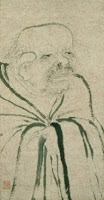
Of old, those who excelled in doing the Dao
were subtle, marvelous, mysterious, and penetrating:
their depth cannot be understood.
It is only because it cannot be understood
that, if I am forced, I would describe them as —
hesitant, like one fording a stream in winter;
tentative, like one concerned by the four neighborhoods;
respectful, like a guest;
dispersed, like melting ice;
genuine, like an uncarved block;
vast, like a valley;
murky, like muddy water.
(Daode jing, 25)
In generating and feeding things
generate but do not own,
do but do not be dependent,
let grow but to not manage.
This is called Mysterious Virtue.
(Daode jing, 10, part.)
Those who intend to take over the world and do something to it—
I see that they will never succeed.
The world is a divine vessel:
you cannot do anything to it,
you cannot hold it.
If you do something to it, you damage it;
if you hold it, you lose it.
Thus the Saint does not do,
and therefore nothing is damaged,
he holds nothing,
and therefore nothing is lost.
(Daode jing, 29, part.)
He does not make himself seen,
therefore he is bright;
he does not deem himself to be right,
therefore he is illustrious;
he does not brag,
therefore he has merit;
he does not boast,
therefore he lasts long.
It is only because he does not contend
that no one in the world contends with him.
(Daode jing, 22, part.)
Read more on the Daode jing (Book of the Way and Its Virtue) on these pages of the Golden Elixir website:
Daode jing (from The Encyclopedia of Taoism)
"The Roots of Taoism"

Published on May 14, 2012 10:57
March 27, 2012
Vol. 2 of The Seal of the Unity of the Three Just Published
Golden Elixir Press is pleased to announce the publication of Vol. 2 of The Seal of the Unity of the Three, subtitled Bibliographic Studies on the Cantong qi: Commentaries, Essays, and Related Works, by Fabrizio Pregadio.
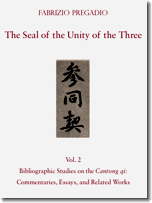
The Cantong qi is the main text of Taoist Internal Alchemy (Neidan). In addition to Taoist masters and adepts, it has also attracted the attention of philosophers, cosmologists, poets, literati, calligraphers, philologists, and bibliophiles. Thirty-eight traditional commentaries written through the end of the nineteenth century are extant, and dozens of texts found in the Taoist Canon and elsewhere are related to it. The present book is the most complete guide to this vast literature available in any language.
The book is divided into two main parts. Part 1 contains a catalogue of extant and lost commentaries, essays, and related texts, listing altogether about 150 works with details on their authors, editions, reprints, and bibliographic records. Part 2 contains a survey of the textual tradition originated by the Cantong qi, focused on the composition and contents of about 40 major texts. A final index of authors, editors, titles, and editions facilitates the use of the book.
The book is offered with a 20% early publication discount until April 30, 2012. Please see below for this offer.
• Visit the Web page on this book
• Download a free PDF sample
Note: This book is a companion to the complete translation found in Vol. 1, subtitled A Study and Translation of the Cantong qi, the Source of the Taoist Way of the Golden Elixir (see the web page). The two volumes can be purchased separately.
Publication Data
Fabrizio Pregadio
The Seal of the Unity of the Three
Vol. 2. Bibliographic Studies on the Cantong qi:
Commentaries, Essays, and Related Works
Golden Elixir Press, 2012
ISBN 978-0-9843082-9-3
Paperback, 278 pp., US$ 23.95 (list price)
Early Publication Discount: US$ 19.16 (20% discount)
Buy from CreateSpace.com — Enter discount code XK73HZN5 at checkout
This offer is valid until April 30, 2012 (*)
(*) By the time your read this post, Amazon.com and other online bookstores may sell this book with a discount even higher than 20%. Golden Elixir Press does not activate or influence any discount offered by online bookstores.

Published on March 27, 2012 14:49
January 13, 2012
Golden Elixir Press — Winter 2012 Catalogue
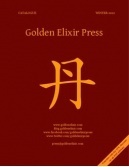 The new Winter 2012 Catalogue is available. Click the picture or the link below to access the download page:
The new Winter 2012 Catalogue is available. Click the picture or the link below to access the download page:• Winter 2012 Catalogue
As usual, the catalogue includes a code for a 10% discount on all PDF editions. This offer is valid until the end of Winter (March 20, 2012).

Published on January 13, 2012 11:06
January 8, 2012
Interview with Fabrizio Pregadio
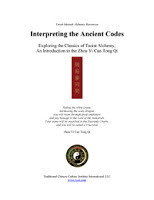
An Introduction to the Classics
of Taoist Alchemy.
Available for free download from TCCII.
These excerpts are reproduced from the post entiled Interview with Fabrizio Pregadio, accessible from the Silent Tao website. Shawn Cartwright, who conducted the interview, is a co-founder of the Traditional Chinese Culture Institute International (TCCII), and a teacher of several Chinese internal arts. His website contains many materials of interest on Neidan (Internal Alchemy). The full interview is available in a PDF edited by Shawn, entitled Interpreting the Ancient Codes of Taoist Alchemy.
Interview with Fabrizio Pregadio
By Shawn Cartwright
Fabrizio Pregadio, one of the foremost translators of Taoist Alchemy classics, answers several questions about his work translating some of the most important texts of Nei Dan. Here is a selection of questions and his answers from the interview. The full interview can be found in the paper Interpreting the Ancient Codes available as a free download from TCCII.
Q: How did you become interested in Taoism and Taoist alchemy?
A: I was, and I still am, delighted by how Taoism represents the relation between the absolute principle (the Dao) and its manifestation in the world in which we live, and by how clearly it formulates several ways to realize the "return to the Dao." The essential features of these teachings are found in the Dao De Jing and are elaborated on (with some differences in emphasis) in the Zhuang Zi. Taoist Internal Alchemy (Nei Dan) is the main tradition that applies those teachings to the human being and offers a way to comprehend and realize them at the individual level.
Q: What benefit can internal alchemy practitioners derive from studying the classic texts?
A: What you call "classical texts" are signposts in the history of a tradition. By studying those texts, one can study the history of a tradition and how it has been transmitted and adapted to different circumstances.
Texts, moreover, are often the only sources we have to reconstruct the history of a tradition, and this is especially important with regard to Nei Dan. We often think of Nei Dan as a "school" of Taoism, but this is by no means correct. Nei Dan is best described as a tradition with Taoism, with its own branches, schools (or rather, lineages), and individual representatives. There are often major differences among the different Nei Dan lineages. Studying texts is virtually the only way to identify those differences.
There’s one more important thing. I can hardly imagine a Chinese — or Indian, Japanese, Tibetan, Persian, etc. — adept of a tradition who does not know, study, and often memorize the main texts of his or her tradition. Knowledge of the written records of a tradition should also be important for a Western follower. Without that knowledge, a Western follower could easily end up twisting and distorting the tradition that he or she claims to belong to, according to his or her own particular perspective. Any Eastern tradition teaches exactly the opposite attitude: until one reaches a truly advanced stage, one should follow the tradition "as is," with no attempt to reinterpret it or adapt it to any contingent circumstance. The re-adaptation (or rather, re-codification) of a teaching to different historical or social circumstances is a very important and interesting phenomenon in the history of any traditional teaching.
Q: Who is the intended audience of your translation of the Can Tong Qi?
A: The intended audience is, generally, everyone who is interested for any reason in the doctrines of the Way of the Golden Elixir, as they are presented by the main textual source of this tradition.
Q: You mention in your translation of the Can Tong Qi that you began your work on it back in 1990. Why is this text so interesting to you?
A: Why is the Can Tong Qi so interesting to me? Well, first of all because, in 1990, after I finished my dissertation on Wai Dan, I told myself, "I’d like to work on the main text in Taoist alchemy" and less than one second later I thought, "This means I should translate the Can Tong Qi." Second, because this text is crucial to understand Taoist alchemy in virtually all of its aspects. One important point here is that the Can Tong Qi talks almost exclusively of doctrine, but we (in the 21st century) should not think that the "doctrine" of a traditional teaching is equivalent to a "theory" in the modern sense of the term. A theory is something that requires proof, and is subject to change in the course of time. A doctrine is something from which a whole tradition develops, and from which the practices are devised. The concepts of "theory" and "proof" are entirely alien to traditional thought; you have, instead, a doctrine that requires personal comprehension and verification. This is why the Can Tong Qi is so important: it has provided the basic doctrine for virtually the entirely history of Chinese alchemy, in all of its forms, with the only exception of the Wai Dan texts written before it was composed, and of some later Wai Dan texts that are not related to it.
Download the full interview now .

Published on January 08, 2012 04:08



